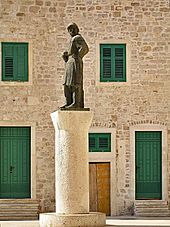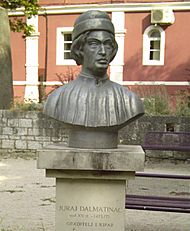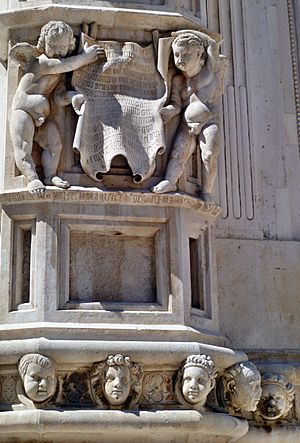Giorgio da Sebenico facts for kids
Quick facts for kids
Giorgio da Sebenico
|
|
|---|---|
| Juraj Dalmatinac | |

A modern sculpture of the artist created by Ivan Meštrović, placed in front of the Šibenik Cathedral
|
|
| Born | circa 1410 |
| Died | 10 October 1473 |
| Known for | stone carving |
Giorgio da Sebenico (which means George of Sebenico) or Juraj Dalmatinac (meaning George the Dalmatian) was a very important sculptor and architect. He lived from about 1410 to 1473. He was from a region called Dalmatia, which was part of the Republic of Venice. He mostly worked in Šibenik, Croatia, and in the city of Ancona, Italy.
Contents
Life of Giorgio da Sebenico
Giorgio da Sebenico was born around 1410 in Zadar, a city in Dalmatia. At that time, Zadar was part of the powerful Republic of Venice. His family was known as the Orsini family.
When he was young, Giorgio moved to Venice. There, he likely learned how to be a sculptor. He might have trained with famous sculptors like Giovanni and Bartolomeo Bon. He must have been very skilled, because in 1441, he was chosen for a huge project in Šibenik.
Working on Šibenik Cathedral
In 1441, Giorgio was called to Šibenik to lead the building of the Šibenik Cathedral of St James. He moved there and, by 1443, he was officially named the master architect. He agreed to live in Šibenik for at least six years. In 1446, he extended his contract for another ten years.
Giorgio worked on the Cathedral from 1441 until 1473. The work was sometimes stopped because there wasn't enough money or because of a fire. He was allowed to visit Venice for two months every two years, but only to work on his own house.
In Venice, he married Elisabetta Da Monte. She brought him some houses in Venice as part of her dowry. After 1450, he worked in both Ancona and Šibenik. He also spent some time in Dubrovnik from 1464 to 1465, helping with city defenses. He even traveled to Rome in 1470–71. He is thought to have died in Šibenik on October 10, 1473.
It is believed that his family lived in Šibenik until the late 1600s.
Giorgio's Amazing Work
Giorgio da Sebenico's art marks a special time in Dalmatian history. He was one of the main artists of the Adriatic Renaissance. This was a style that became popular in the late 1400s in Venice, Dalmatia, and parts of Italy.
His style was based on the Late Gothic art from Venice. However, he was also very interested in the new Renaissance style from Florence, Italy. You can see influences from famous Florentine artists like Donatello and Lorenzo Ghiberti in his sculptures.
Šibenik Cathedral
His most famous work is the Šibenik Cathedral of St James. He was the main architect for this cathedral from 1441 to 1473. The entire building was made only from limestone, with no wood or bricks.
Around the outside of the building, there is a fence with 72 stone-carved heads. On the north side, Giorgio added two angels. At the bottom of this work, he carved his signature. His job was to build the choir, raise the main part of the church (the nave), and add a dome.
Unfortunately, the work was delayed by a lack of money and a fire. After Giorgio's death, another architect, Niccolò di Giovanni Fiorentino, continued the work from 1477.
Other Important Projects
- Split: In Split, he built several palaces. In 1448, he carved a stone altar in the Cathedral of Saint Domnius. It has a remarkable carving of the flagellation of Christ.
- Dubrovnik: In Dubrovnik, he helped repair the Duke's Palace. He also helped build the Minčeta fortress in 1464 and 1465.
- City Planning: Giorgio was also a skilled city planner. Around 1450, he created a city plan for Pag. He also helped design and build the walls of Pelješac. He was a sculptor, architect, and city planner all at once, which was common for artists during the Renaissance.
- Italy: In Ancona, Italy, he built the Loggia dei Mercanti. He also created the beautiful portals (entrances) for the churches of San Francesco alle Scale and Sant'Agostino.
During his career, the Renaissance style slowly replaced the older Gothic style. The Gothic style became more detailed and fancy in the 1400s, known as Gotico Fiorito in Venice.
Some of his students included Andrea Alessi and Radmillo Allegretti. Their works can be found in Kotor and Zadar.
What Was His Name?
At the base of two Renaissance statues on the north side of the Šibenik Cathedral, Giorgio signed his work in Latin. He wrote: "hoc opus cuvarum fecit magister Georgius Mathaei Dalmaticus." This means "Master George, son of Matthew, the Dalmatian, made this work." On a contract from 1441, he signed as "Georgius lapicida quondam Mathei de Jadra Civis Sibenicenis." This means "George the stonecutter, son of Matthew from Zadar, citizen of Šibenik." These are the only known signatures of the artist.
He is most commonly known as Giorgio da Sebenico, or Giorgio Orsini, especially in Italian writings. Sometimes he is called "Giorgio Dalmatico" or "George the Dalmatian." In Croatia, he is known by his Croatian name, Juraj Matejev Dalmatinac. Interestingly, Giorgio himself never used the family name Orsini. His son adopted it after Giorgio's death.
Images for kids
-
Altar detail in the Cathedral of Saint Domnius, Split
-
Loggia dei Mercanti, Ancona
-
Minčeta Tower, Dubrovnik
-
Rector's Palace, Dubrovnik
-
Rector's Palace, Dubrovnik

See also
 In Spanish: Giorgio Orsini para niños
In Spanish: Giorgio Orsini para niños


















